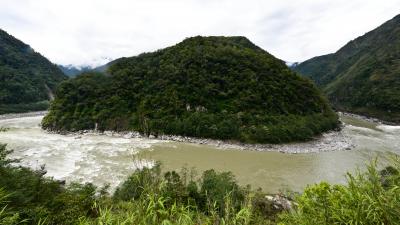Beijing – China’s ambitious Medog Hydropower Station on the Yarlung Tsangpo River in Tibet poses a serious threat to the cultural, spiritual, and geographical essence of Tibetan identity, according to a report published on Wednesday.
Billed as a “Project of the Century,” the Medog Hydropower Station is envisioned as the most powerful dam ever built by China, promising clean energy, economic development, and strategic benefits. However, beneath this celebratory narrative lies a disturbing silence surrounding the project’s potential impact on the Tibetan people, their land, and their way of life, wrote Jianli Yang, a research fellow at Harvard University’s Kennedy School of Government, in The Diplomat.
Drawing comparisons to the Three Gorges Dam—previously China’s most ambitious infrastructure effort—the report recalled the displacement of over 1.3 million people, the submergence of cultural and historical sites, and the disruption of entire ecosystems. Despite minimal compensation and resettlement efforts, many communities were left uprooted, and the resulting social trauma continues to echo through lost livelihoods and fractured families.
“Tibet now stands on the brink of a similar upheaval—but with potentially even deeper consequences,” the report warned. For Tibetans, the land is sacred, and the Yarlung Tsangpo River is more than a waterway—it is revered as a spiritual mother, flowing from glaciers near Mount Kailash through a sacred terrain. The Great Bend of the river, where the dam is being constructed, is especially venerated as the heart of Pemako, a mystical paradise foretold in Tibetan prophecy to safeguard humanity in times of catastrophe.
“To alter or submerge this landscape is not merely a matter of relocating villages—it is a desecration of a spiritual geography embedded in myths, traditions, and pilgrimage,” the report stated.
Unlike the industrialized Three Gorges region, Medog remains one of the last strongholds of Tibetan cultural and ecological purity. Any forced relocation here, the report stressed, would result in not just physical displacement but also cultural erasure. Temples, meditation caves, sacred mountains, and pilgrimage routes form an irreplaceable tapestry of Tibetan identity that cannot be replicated elsewhere or compensated for with monetary aid.
Yang pointed out that, in contrast to the Three Gorges project—where public displacement figures and resettlement plans were at least somewhat transparent—the Yarlung Tsangpo project is advancing under a veil of secrecy. This silence, he argued, is emblematic of China’s broader policy toward Tibet: a model of “development” that often equates progress with assimilation, driven by urbanization, tourism, resource extraction, and now, large-scale hydropower.
The report concluded by stating that China faces a critical choice: either repeat the mistakes of the Three Gorges Dam by displacing communities under the guise of “power and prosperity,” or pursue a more thoughtful path—one that treats Tibet not as a blank canvas for engineering ambition, but as a living civilization that deserves protection, respect, and a voice.
With inputs from IANS

